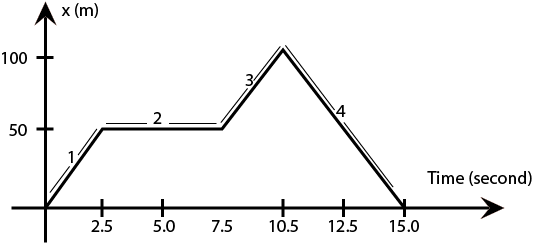Question
Question: The figure shows the graph of the x-coordinate of a particle going along the x-axis as a function of...
The figure shows the graph of the x-coordinate of a particle going along the x-axis as a function of time. Find (a) the average velocity during 0 to 10 seconds. (b) instantaneous velocity 2, 5, 8 and 12 sec.
(A) (a)1Mm/sec, (b) 20m/sec, zero, 20m/sec, -20m/sec.
(B) (a)20m/sec, (b) 15m/sec, zero, -10m/sec, 15m/sec.
(C) (a)15m/sec, (b) 15m/sec, 10m/sec, -15m/sec, 20m/sec.
(D) (a)25m/sec, (b) 10m/sec, -10m/sec, zero, 20m/sec.

Solution
Hint First, we will calculate displacement of an object from 0 to 10 seconds. Then we will calculate average velocity using the displacement value in formula ∨ˉ=dtdx .
Vinst= slope of the graph is used to calculate instantaneous velocity.
Complete step by step solution:
Average velocity: It is defined as the rate of change of velocity of an object. It tells us how much displacement is done by an object in a specific time range.
Average velocity during 0 to 10 seconds = (total displacement) / (total time taken
=10(100−0)
=10m/sec
Instantaneous velocity = slope of graph
= change in y axis / change in x axis
Velocity at a particular instant is known as instantaneous velocity. Formula t→0limΔtΔx is used in numerical calculations.
At 2 sec = slope of (1) =2.5−050−0
=20m/sec
At 5 sec = slope of (2) =7.5−2.550−50
= zero
At 8 sec = slope of (3) =10.5−7.5100−50
=2.550
= 20m/sec
At 12 sec = slope of (4) =15−100−100
=5−100
=-20m/sec
so, we are left with only one correct option I.e. (A) part.
Note:
Instantaneous velocity can be positive, zero, negative whereas average velocity should be positive always. We cannot use t→0limΔtΔx to calculate instantaneous velocity. Since, we get average velocity as 10m/s
